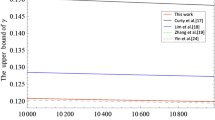Abstract
In quantum secure direct communication (QSDC), messages are transmitted directly through quantum channels. The decoy state scheme has been widely studied to detect eavesdroppers and improve the secrecy capacity. However, the secret key rate becomes relatively low in this scheme because of the finite-size effect. In this study, the statistical fluctuation analyses of a four-intensity decoy-state QSDC system were performed, and a numerical simulation was conducted in an actual experimental environment. The simulation results were compared, and the parameters optimized using the Gaussian analysis and the Chernoff bound were presented.


Similar content being viewed by others
Data availability
All data generated or analyzed during this study are included in this published article.
References
Bennett, C.H., Brassard, G.: Quantum cryptography: public key distribution and coin tossing. arXiv preprint arXiv:2003.06557, (2020)
Lo, H.-K., Chau, H.F.: Unconditional security of quantum key distribution over arbitrarily long distances. Science 283(5410), 2050–2056 (1999)
Shor, P.W., Preskill, J.: Simple proof of security of the bb84 quantum key distribution protocol. Phys. Rev. Lett. 85(2), 441 (2000)
Mayers, D.: Unconditional security in quantum cryptography. J. ACM 48(3), 351–406 (2001)
Long, G.-L., Liu, X.-S.: Theoretically efficient high-capacity quantum-key-distribution scheme. Phys. Rev. A 65(3), 032302 (2002)
Deng, F.-G., Long, G.L., Liu, X.-S.: Two-step quantum direct communication protocol using the einstein-podolsky-rosen pair block. Phys. Rev. A 68(4), 042317 (2003)
Fu-Guo, D., Gui, L.L.: Secure direct communication with a quantum one-time pad. Phys. Rev. A 69(5), 052319 (2004)
Wang, C., Deng, F.-G., Li, Y.-S., Liu, X.-S., Long, G.L.: Quantum secure direct communication with high-dimension quantum superdense coding. Phys. Rev. A 71(4), 044305 (2005)
Hu, J.-Y., Ming-Yong Jing, B.Y., Xiao, L.-T., Jia, S.-T., Qin, G.-Q., Long, G.-L.: Experimental quantum secure direct communication with single photons. Light Sci. Appl. 5(9), e16144–e16144 (2016)
Zhang, W., Ding, D.-S., Sheng, Y.-B., Zhou, L., Shi, B.S., Guo, G.C.: Quantum secure direct communication with quantum memory. Phys. Rev. Lett. 118(22), 220501 (2017)
Zhu, F.: Experimental long-distance quantum secure direct communication. Sci. Bull. 62(22), 1519–1524 (2017)
Qi, Ruoyang, Sun, Zhen, Lin, Zaisheng, Niu, Penghao, Hao, Wentao, Song, Liyuan, Huang, Qin, Gao, Jiancun, Yin, Liuguo, Long, Gui-Lu.: Implementation and security analysis of practical quantum secure direct communication. Light Sci. Appl. 8(1), 1–8 (2019)
Pan, D., Lin, Z.: Experimental free-space quantum secure direct communication and its security analysis. Photonics Res. 8(9), 1522–1531 (2020)
Wyner, A.D.: The wire-tap channel. Bell Syst. Tech. J. 54(8), 1355–1387 (1975)
Brassard, G., Lütkenhaus, N., Mor, T., Sanders, B.C.: Limitations on practical quantum cryptography. Phys. Rev. Lett. 85(6), 1330 (2000)
Lütkenhaus, N.: Security against individual attacks for realistic quantum key distribution. Phys. Rev. A 61(5), 052304 (2000)
Hwang, W.-Y.: Quantum key distribution with high loss: toward global secure communication. Phys. Rev. Lett. 91(5), 057901 (2003)
Lo, H.-K., Ma, X., Chen, K.: Decoy state quantum key distribution. Phys. Rev. Lett. 94(23), 230504 (2005)
Ma, X., Qi, B., Zhao, Y., Lo, H.-K.: Practical decoy state for quantum key distribution. Phys. Rev. A 72(1), 012326 (2005)
Curty, M., Feihu, X., Cui, W., Lim, C.C.W., Tamaki, K., Lo, H.-K.: Finite-key analysis for measurement-device-independent quantum key distribution. Nat. Commun. 5(1), 1–7 (2014)
Tomamichel, M., Lim, C.C.W., Gisin, N., Renner, R.: Tight finite-key analysis for quantum cryptography. Nat. Commun. 3(1), 1–6 (2012)
Zhang, Z., Zhao, Q., Razavi, M., Ma, X.: Improved key-rate bounds for practical decoy-state quantum-key-distribution systems. Phys. Rev. A 95(1), 012333 (2017)
Trushechkin, A.S., Kiktenko, E.O., Fedorov, A.K.: Practical issues in decoy-state quantum key distribution based on the central limit theorem. Phys. Rev. A 96(2), 022316 (2017)
Park, J., Lee, J., Heo, J.: Improved statistical fluctuation analysis for twin-field quantum key distribution. Quantum Inf. Process. 20(4), 1–9 (2021)
Biswas, A., Banerji, A., Lal, N., Chandravanshi, P., Kumar, R., Singh, R.P.: Quantum key distribution with multiphoton pulses: an advantage. Opt. Contin. 1(1), 68–79 (2022)
Acknowledgements
This work was supported by Institute of Information & communications Technology Planning & Evaluation (IITP) grant funded by the Korea government(MSIT) (No.2022-0-00463, Development of a quantum repeater in optical fiber networks for quantum internet). This research was supported by the MSIT(Ministry of Science and ICT), Korea, under the ITRC(Information Technology Research Center) support program(IITP-2023-2021-0-01810) supervised by the IITP(Institute for Information & Communications Technology Planning & Evaluation).
Author information
Authors and Affiliations
Corresponding author
Ethics declarations
Conflicts of interest
The authors declare that they have no conflict of interest.
Additional information
Publisher's Note
Springer Nature remains neutral with regard to jurisdictional claims in published maps and institutional affiliations.
Rights and permissions
Springer Nature or its licensor (e.g. a society or other partner) holds exclusive rights to this article under a publishing agreement with the author(s) or other rightsholder(s); author self-archiving of the accepted manuscript version of this article is solely governed by the terms of such publishing agreement and applicable law.
About this article
Cite this article
Park, J., Kim, B. & Heo, J. Statistical fluctuation analysis for decoy-state quantum secure direct communication. Quantum Inf Process 22, 112 (2023). https://doi.org/10.1007/s11128-023-03845-1
Received:
Accepted:
Published:
DOI: https://doi.org/10.1007/s11128-023-03845-1




